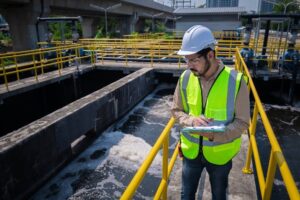 The EPA established the Clean Water Act (CWA) to set restrictions for point-source water pollution. Over 50 years and several amendments later, in a landscape of new emerging contaminants and a freshly passed infrastructure bill, the work is far from over. But efforts so far have helped chart out a detailed map of the greatest challenges facing states when it comes to clean water.
The EPA established the Clean Water Act (CWA) to set restrictions for point-source water pollution. Over 50 years and several amendments later, in a landscape of new emerging contaminants and a freshly passed infrastructure bill, the work is far from over. But efforts so far have helped chart out a detailed map of the greatest challenges facing states when it comes to clean water.
The Citylitics Environmental Monitoring Dashboard, which analyzes the EPA’s CWA violation database, identifies the most persistent pollutant threats faced by states in the past three years, as well as regional hotspots for each category. This article specifically examines nutrient pollution, one of the most significant pollutant categories.
The impact of nutrient pollution
Nutrient pollution, primarily caused by phosphorus, nitrogen, and ammonia, is a pressing concern for ecosystems worldwide. With significant contributions from agricultural, industrial activities, and wastewater treatment processes, nutrient pollution fuels harmful algal blooms that disrupt aquatic life and have long-lasting ecological consequences.
Who is impacted the most?
Ohio and Missouri, for example, have experienced thousands of nutrient violations over the past three years due to a combination of factors. In this article, we will explore the latest advancements in wastewater treatment and management technologies that specifically target nutrient pollution and discuss how companies can leverage these innovations to enhance their proposals for infrastructure projects.

Phosphorus removal technologies
Phosphorus removal from wastewater has become a crucial aspect of nutrient pollution control. New advancements in this field include enhanced biological phosphorus removal (EBPR) and chemical precipitation. EBPR leverages microorganisms to remove phosphorus biologically, while chemical precipitation uses chemicals such as alum or iron salts to bind phosphorus, making it easier to separate from water. Incorporating these technologies in infrastructure project proposals can demonstrate your commitment to addressing phosphorus pollution effectively.
Nitrogen removal through denitrification
Denitrification is a biological process that converts nitrogen in wastewater into nitrogen gas, which is then released into the atmosphere. This process can be enhanced through the use of advanced technologies such as anammox (anaerobic ammonium oxidation) and membrane bioreactors (MBRs). These technologies can significantly improve the efficiency of nitrogen removal from wastewater, providing a sustainable solution to this pressing issue.
Sustainable agricultural practices
Agriculture is a significant contributor to nutrient pollution. Implementing sustainable agricultural practices, such as precision agriculture, crop rotation, and the use of cover crops, can help reduce nutrient runoff from agricultural lands. Integrating these practices into your infrastructure project proposals can show your commitment to addressing nutrient pollution at its source.
Stormwater management solutions
Effective stormwater management is critical for reducing nutrient pollution, particularly in areas with heavy urban and agricultural activity. Innovative stormwater management solutions, such as permeable pavements, green roofs, and bioretention systems, can help to capture, treat, and infiltrate stormwater runoff, reducing the amount of nutrients entering waterways. Including these solutions in your infrastructure project proposals can demonstrate your company’s dedication to sustainable and innovative stormwater management.
Monitoring and data-driven decision-making
Emerging technologies, such as IoT sensors and machine learning algorithms, can help monitor nutrient levels in wastewater and water bodies.
As well, predictive intelligence can identify cities & utilities in need of wastewater treatment & collection technologies, engineering services, or construction services. This includes new equipment, equipment upgrades, new wastewater discharge requirements, design engineering services, master plan studies and more.
By harnessing this data, companies can make informed decisions about when and how to implement nutrient removal technologies and management strategies. Incorporating these advanced monitoring and data analysis techniques in your infrastructure project proposals can show your commitment to a data-driven approach to addressing nutrient pollution.
Addressing nutrient pollution is crucial for ensuring the health of our ecosystems and preserving water quality. By incorporating the latest advancements in nutrient removal technologies, sustainable agricultural practices, stormwater management, and data-driven decision-making into your infrastructure project proposals, you can demonstrate your company’s commitment to finding innovative and sustainable solutions to this pressing issue. As a result, you will not only enhance the competitiveness of your proposals but also contribute to a more sustainable future for our water resources.
Citylitics aggregates mountains of public documents & data generated by cities, utilities, and public agencies and transforms it into critical sales intelligence. To learn more about improving your win rates in infrastructure sales, contact us or request a free sample report.

